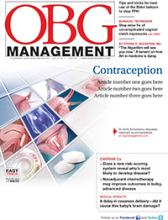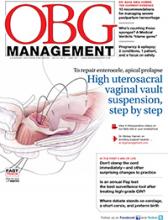“AN APPEAL TO THE FDA: REMOVE THE BLACK-BOX WARNING FOR DEPOT MEDROXYPROGESTERONE ACETATE”
ANDREW M. KAUNITZ, MD; DAVID A. GRIMES, MD (EDITORIAL; AUGUST 2011)
Black box warning for DMPA needs to go
I couldn’t agree more that the black box warning for depot medroxyprogesterone acetate (DMPA) should be removed by the FDA. Since this warning was instituted, I have continued to use the agent with some increased concern and, of course, enhanced informed consent of my patients. It has definitely led to more bone-density scans, which have all been negative in my experience.
Patients do benefit from this treatment, so it makes no sense to create an artificial obstacle to its use in the absence of scientific data.
Terrence McGaw, MD
Reno, Nev
Black box warning encourages defensive practices
I agree that the black box warning should be removed. I have continued to order DMPA for my patients, but for those who have been using it for years, I have also been ordering bone-density studies periodically from a “defensive” medical standpoint.
Paul D. Manganiello, MD
Lebanon, NH
Dr. Kaunitz responds: Routine bone-density assessment is unnecessary
I appreciate the thoughtful letters from Dr. McGaw and Dr. Manganiello, who, like me, continue to find that injectable contraception remains an important option for our patients. One suggestion: Because changes in bone density associated with DMPA are reversible and have not been associated with postmenopausal osteoporosis or fractures, ACOG does not recommend routine bone-density assessment in women using DMPA for birth control.1
“HAVE YOU MADE BEST USE OF THE BAKRI BALLOON IN PPH?”
ROBERT L. BARBIERI, MD (EDITORIAL; JULY 2011)
Pearls for postpartum hemorrhage
I’d like to offer the following pearls for managing postpartum hemorrhage:
If the patient has had an epidural, perform a quick suction dilatation and curettage in the bed. Then suture the cervix at the 9 o’clock and 3 o’clock positions, closing the opening to 4 cm to 5 cm before placing the balloon. I recommend inflating the balloon to 300 cc to 500 cc.
If a balloon is not available, pack the uterus with two lap sponges tied together. Transfuse the patient with “O”-negative blood until the blood can be typed and crossed. If the patient is still bleeding, call an interventional radiologist to place gel foam in the uterine arteries. This procedure can take 1 or 2 hours, so make sure the patient is receiving enough blood products during that time.
Do not take the patient to surgery if she is experiencing disseminated intravascular coagulation.
Wendell Courtney, MD
Leesburg, Fla.
Dr. Barbieri responds: Pearls are appreciated
On behalf of the readers of OBG Management, I thank Dr. Courtney for the wonderful clinical pearls! I will try to incorporate them in my practice the next time I use a Bakri balloon.
“HIGH UTEROSACRAL VAGINAL VAULT SUSPENSION TO REPAIR ENTEROCELE AND APICAL PROLAPSE”
MICKEY KARRAM, MD; CHRISTINE VACCARO, DO (JUNE 2011)
Are delayed absorbable sutures durable?
I loved the article by Dr. Karram and Dr. Vaccaro. I wonder whether they find delayed absorbable sutures to be as durable as permanent sutures? What does the raw surface of the posterior vaginal cuff “heal to” or granulate to when absorbable sutures are used, to allow it to be a permanent fix? In other words, once the suture dissolves, what prevents the cuff from slipping out?
Thomas Wimbrow, MD
Auckland, New Zealand
Dr. Karram and Dr. Vaccaro respond: Scarification can be expected
Although Dr. Wimbrow’s question about absorbable sutures makes sense theoretically, scarification does occur with a delayed absorbable suture such as polyglactin 910 or polydiaxanone, even though there are no raw surfaces. Our 5-year outcome data nicely document this fact.1 We do bar the patient from heavy lifting, exercise, and other strenuous activity for 6 weeks.
“UPDATE ON INFECTIOUS DISEASE”
ALAN T. N. TITA, MD, PHD; AKILA SUBRAMANIAM, MD; WILLIAM W. ANDREWS, MD, PHD (JUNE 2011)
The cesarean-delivery rate will decline only when we are “honest” about the indication
In their article on infectious disease, Dr. Tita and colleagues make mention of the fact that cesarean delivery “accounts for one third (more than 1.3 million) of all births in the United States each year and carries a risk of infection at least five times higher than that associated with vaginal delivery.”
Is the rate of cesarean delivery too damn high? Of course it is! In my decades-long practice in maternal-fetal medicine, in which I cared exclusively for high-risk patients, my cesarean-delivery rate was always lower than that of any hospital I was affiliated with. As I see it, the rate of cesarean delivery is escalating needlessly—and the rising rate benefits the hospital and physician, but not necessarily the patient. Not only the fear of lawsuits, but also significantly better payment for cesarean than for vaginal delivery, plays a role in these numbers. There is also the time factor. With a normal vaginal delivery, a physician may have to sit and wait (without a long cigar nowadays…) and agonize until after the delivery. With cesarean, the job is quite simple, complications are rare, the doc is done within an hour, and everything seems copacetic—until such time as the lawyers start digging, finding faults, and suing even for frivolous negative incidents.



